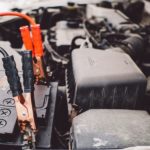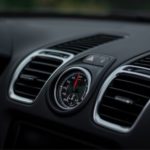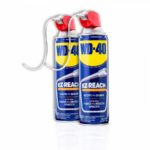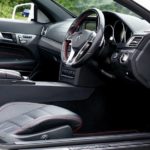Quick Navigation
Hearing water sloshing around in your car’s dashboard can be a concerning and potentially damaging issue.

This sound is caused by various factors, such as a leak in the roof or windows, or a clogged sunroof drain.
Or condensation from the air conditioning unit, or poorly sealed doors or windshields.
Understanding the symptoms, causes, and solutions for water in the car dashboard is crucial.
As it prevents further damage and ensures a safe driving experience.
In this article, we will explore the common causes of water in the dashboard.
Also, we will provide helpful tips on checking, removing, and preventing this problem.
Causes of Water in the Car Dashboard
Why do you hear water sloshing in your car dashboard?
Here are the possible causes that you need to know:
Leaking Roof or Windows
A leak in the roof or windows can allow water to enter the car’s interior, including the dashboard.
Cracks, holes, or poor seals in the ceiling or windows can cause it.
What to Do:
Here’s what you can do if the roof or winding has leakage:
- Inspect the source of the leak: Look for cracks, holes, or other sources of leaks in the roof or windshield.
- Clean the area: Remove any debris or dirt from around the source of the leak to ensure that it is clear and accessible.
- Seal the leak: Use a sealant or silicone caulk to seal any cracks or holes in the roof or windshield.
- Let the sealant dry: Allow the sealant to dry according to the manufacturer’s instructions before using the car.
- Consider professional help: If you cannot effectively seal the leak, consider seeking the assistance of a professional mechanic.
Clogged or Worn-Out Sunroof Drain
The sunroof drain is designed to prevent water from entering the car’s interior.
However, water can accumulate and enter the dashboard if it becomes clogged.
What to Do:
To address this issue, you should follow these steps:
- Locate the sunroof drain: The sunroof drain is typically located near the sunroof opening.
- Clear the drain: Use a coat hanger or other similar tool to clear any debris or obstructions from the sunroof drain.
- Check for damage: Inspect the sunroof drain for any signs of wear or damage.
- Replace the drain if necessary: If the drain is damaged, replace it with a new one.
- Test the drain: After clearing or replacing it, run water over the sunroof to ensure it is functioning correctly.
- Consider professional help: If you cannot effectively clear or replace the sunroof drain, consider seeking the assistance of a professional mechanic.

By taking these steps, you can effectively repair a clogged or worn-out sunroof drain.
Also prevent water from entering your car’s interior.
Air Conditioning Unit Condensation
The air conditioning unit can produce condensation that can accumulate and enter the dashboard if not adequately drained.
What to Do:
Here’s what you do when your car’s air conditioning has condensation:
- Examining the air conditioning unit for condensation. Check the air conditioning unit for any signs of condensation or water buildup. It may indicate an issue with the draining system.
- If there is condensation, the best way to unclog a condensate drain is to compress the air. Find the evaporator drain tube under your car and blow compressed air into the tube opening. If no compressed air is available, try placing a flexible wire in the tube hole to unclog the drain.
- Repairing the air conditioning unit: If the air conditioning unit is causing water to enter the car’s interior, it is important to repair or replace the unit as soon as possible.
Poorly Sealed Doors or Windshield
If the doors or windshield are not properly sealed, water can enter the car’s interior, including the dashboard.
It may be due to worn or damaged seals or a failure to close the doors or windows completely.
What to Do:
Here’s what you do when your car doors or windshield has poor sealant:
- Check for the door or windshield that is poorly sealed.
- Replacing damaged or worn seals: If the doors or windshield are not properly sealed, it is important to replace the damaged or worn seals. It will prevent water from entering the car’s interior.
- Repair or seal the doors or windshield properly. If you need help doing it, ask for help from an experienced mechanic.
Flooding
In the case of flooding, water can enter the car through various openings and potentially reach the dashboard.
What to Do:
Here’s what to do if your car dashboard has water due to flooding:
- Remove excess water if there is a large amount of water inside the car. Use a pump or towels to remove as much as possible. Dry the interior and use towels or a fan to dry the car’s interior.
- Remove the carpet and floor mats, if the floor is wet and let them dry.
- Disconnect the battery: To prevent electrical damage, disconnect the battery.
- Remove the dashboard: If the dashboard is wet, remove it to allow it to dry.
- Inspect for damage: Check for damage to the electrical and mechanical components of the car.
- Consider professional help: If the car has suffered significant damage, consider seeking the assistance of a professional mechanic.
Ensure that you park your car in a non-flooding area to avoid water entering your car during stormy weather conditions.
Or park it in a covered area to avoid water penetration during the rainy season.

Prevention of Water in the Car Dashboard
Here’s how you can prevent water from entering or staying in your dashboard:
- Do a regular inspection: Regularly inspect the car’s interior, including the dashboard, for signs of water damage or leaks.
- Repairing leaks promptly: If a leak is detected in the roof or windows, it is important to repair the leak promptly. It will prevent water from entering the car’s interior.
- Regular cleaning of the sunroof drain: Regularly clean the sunroof drain to ensure that it is functioning properly. Also, prevents water from entering the interior of the car.
- Regular maintenance of the air conditioning unit: Regular maintenance can help prevent water from entering the car’s interior through the draining system.
- Replacing worn or damaged seals: Replacing worn or damaged seals around the doors or windshield can help prevent water from entering the car’s interior.
- Park under cover: Park the car when possible, especially during heavy rain or snow, to reduce the risk of water entering the vehicle’s interior.
Implementing these preventive measures can reduce the risk of water entering the car dashboard and ensure a safe and dry driving experience.
Conclusion
Water in the car dashboard is a common issue caused by several factors, such as leaks in the roof or windows, clogs in the sunroof drain, or problems with the air conditioning unit.
The presence of water in the dashboard can cause damage to the interior of the car, as well as create a hazardous driving environment.
To address this issue, remove the water, repair any leaks or damage, and implement preventive measures to reduce the risk of water entering the dashboard in the future.
Following these steps, you can ensure a safe and dry driving experience for you and your passengers.

Kevin has been hanging around cars and automobile magazines since he knew what a car is. He grew up in his father’s 1995 Mercedes E320 Wagon and Volkwagon Phaeton W12 2004. He rides his first car, a manual 1979 Porche 911SC.
Currently, he owns an Acura Integra GS-R. During his childhood, he showed a keen interest in how things actually work and fix them. This passion transforms into his eternal love for cars and bestows him an ideal position in one of the leading automobile companies; whenever he finds time, he takes out his Acura and opts for the longest possible route to find hidden wholesome pleasure in a road trip.
Want to read some of the articles written by Kevin? Head to our blog section to find out all the articles written by Kevin.







